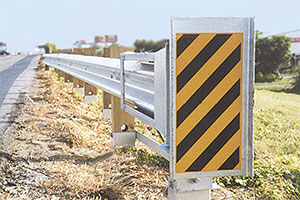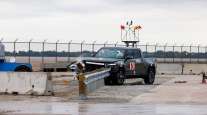Guardrail Maker Defrauded US of $175 Million and Created Hazard, Jury Says

Secret changes by Trinity Industries Inc. to its guardrail systems were found by a jury to have cheated the U.S. government, exposing the company to $1 billion in liability and sending shares plummeting as states question the safety of the product.
The verdict comes as scrutiny of Trinity’s ET-Plus device intensifies across the country after it’s been blamed for multiple deaths. The Federal Highway Administration this month asked all states to start submitting information on crashes involving the ET-Plus to the agency’s safety office.
The agency, which approves products for use on federal highways, will evaluate the findings of the case and “consider whether it affects the continued eligibility of the ET-Plus,” Brian Farber, a spokesman for the Department of Transportation, said in an e-mail after yesterday’s verdict by a federal jury in Marshall, Texas.
About a decade ago, Trinity changed the design of the ET-Plus, according to a whistle-blower lawsuit filed by competitor Joshua Harman. Instead of acting as a crash cushion, it can seize up and impale vehicles that hit the end of a guardrail, Harman claimed. The company didn’t disclose the changes to the federal government as required and the guardrails remained eligible for federal reimbursements, according to Harman’s lawyers.
Jurors deliberated for about 3 1/2 hours before finding the guardrail maker cheated the government of $175 million.
Damages to be awarded against the company will be tripled and added to a penalty to be determined by the judge, with total liability possibly reaching $1 billion, a company lawyer said in May. The company had $934 million in cash and equivalents available as of June 30, according to financial reports. The $525 million jury verdict is the third biggest in the U.S. this year.
The jury wasn’t asked to rule on whether the revised ET-Plus is defective. That’s a question that will be left to the jurors who decide the outcome of more than a dozen pending injury and wrongful death lawsuits against Trinity.
“What happens when we continue to see failures of these guardrails and people getting injured and killed? That’s going to be the bigger question,” said Sean Kane, president of Rehoboth, Massachusetts-based Safety Research & Strategies Inc., a product-hazard research group. “We’ve got a long road ahead of us.”
Four states have banned new installations of the ET-Plus on their highways, citing ongoing investigations.
Nevada, which removed the ET-Plus from its list of approved products in January, isn’t planning to dismantle already-installed ET-Plus end terminals because of the verdict, said Meg Ragonese, a spokeswoman for the state’s transportation department.
The state is looking for “Federal Highway Administration-verified guidance and test results” before deciding whether to approve the modified version, Ragonese said.
Trinity said it will appeal the jury verdict.
“The company respects the jury’s decision,” Trinity said in an e-mailed statement. “However, Trinity believes the decision cannot and will not withstand legal scrutiny.”
This is the second time the case has been tried. The first ended in a mistrial in July after the judge said both sides created an environment in which the jury couldn’t reach a fair verdict.
The product in question is a 175-pound steel mechanism that mounts onto the end of a guardrail and is meant to cushion the impact of a crashing car. Instead of acting like a shock absorber, Trinity’s secretly revised version locks up, transforming the guardrail into a giant shiv, according to the lawsuit.
Harman, a maker and installer of guardrail systems in Virginia, sued in 2012 after he observed multiple instances of the product jamming up during car accidents, at crash sites from Tennessee to New Mexico. Since then, he has road-tripped around the country to document more accidents and find victims who might have been injured by an ET-Plus.
Last year, the 45-year-old spent more than 300 days on the road away from his wife and two school-age daughters.
Harman is eligible for as much as 30 percent of any judgment.
“He has spent the last couple years of his life trying to get some action done,” Sam Baxter, one of Harman’s lawyers, told the jury during closing arguments yesterday. “He is the hero in this case.”
Although the original ET-Plus was crash-tested and federally approved, the modified version was never properly tested or disclosed to the government, lawyers for Harman argued during the trial. The federal government helps state transportation departments purchase approved products, including the ET-Plus, for use on highways across the country.
“We are pleased the jury recognized what has been overlooked for three years and saw the plain truth” that the government was defrauded, Nicholas Gravante Jr., a plaintiffs’ lawyer with Boies, Schiller & Flexner LLP, said in an e-mail.


